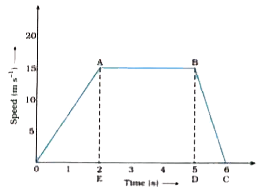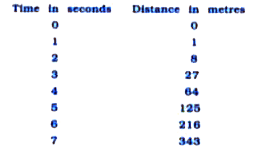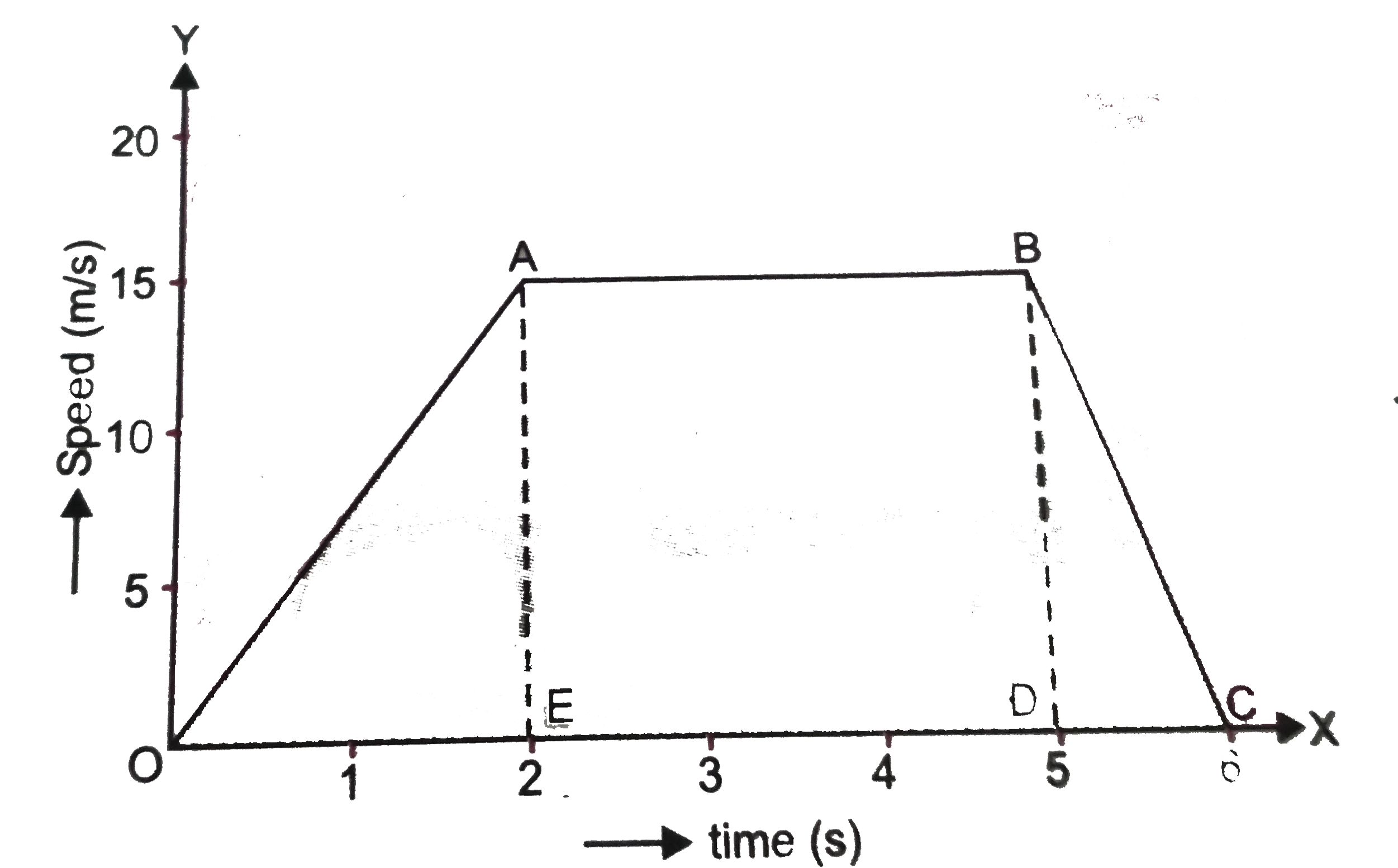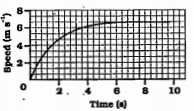The speed-time graph of a car is given the car weights 1000 kg.
(a)What is the distance travelled by the cat in first 2 seconds?
(b)What is the breaking applied at the end of 5 second to brong the car to stop within one second?
 Solution in Gujrati
Solution in Gujrati
(a)Here ,t=2s,v=15 ms−1
Distance =speed × time
=15ms−1×2s=30m
(b)The car stops.
∴v=0,u−15ms−1,t=1s
Acceleration a=v−ut
=0−151=−15ms−2
The magnitude of the acceleration is 15ms−2
The force applied to bring the car to stop.
F=ma=1000kg×15ms−2=15,000N
(a)Distance covered by the car is 30 m.
(b)The force applied is 15,000N
Topper's Solved these Questions
- BOOK - KUMAR PRAKASHANCHAPTER - FORCE AND LAWS OF MOTIONEXERCISE - Additional Exercise4videos
FORCE AND LAWS OF MOTION
- BOOK - KUMAR PRAKASHANCHAPTER - FORCE AND LAWS OF MOTIONEXERCISE - Additional Numericals for Practice18videos
FORCE AND LAWS OF MOTION
- BOOK - KUMAR PRAKASHANCHAPTER - FORCE AND LAWS OF MOTIONEXERCISE - QUESTIONS AND ANSWERS(Solve the following examples/numericals :)8videos
FORCE AND LAWS OF MOTION
- BOOK - KUMAR PRAKASHANCHAPTER - GRAVITATIONEXERCISE - ACTIVITY 10.42videos
GRAVITATION
Similar Questions
The following is the distance-time table of an object in motion:

(a)What conclusion can you draw about the acceleration ?Is it constant. Increasing decreasing ir zero? (b)What do you infer about the force acting on the object?07:32View SolutionThe velocity of an object of mass 50 kg increases from 3 ms−1 to 12 ms−1. What will be the force required for this?
03:35View SolutionA constant force acts on an object of mass 5kg for a duration of 2s.It increases the object's velocity from 3 ms−1 to 7 ms−1.Find the magnitude of the applied force .Now if the force was applied for a duration of 5s,What would be the final velocity of the object ?
03:30View SolutionTake an empty plastic bottle . Close the mouth of the bottle with an airtight stopper . Put it in a bucket filled with watere . The bottle floats .
Push the bottle into the water. You feel an upward push. Try to push it further down. You will find it difficult to push deeper and deeper. Water exerts a force on the bottle in upward direction. Now release the bottle. It bounces back to the surface.
Does the force due to the gravitational attraction of the earth act on this bottle? If so, why doesn't the bottle stay immersed in water after it is released ?01:57View SolutionA driver of a car A travelling at 54km/h applies the brakes and stops the car in 4 seconds. Another driver of car B travelling at 36km/h applies the brakes and stops the car in 6 seconds. Plot speed versus time graphs for the two car. which of the cars travelled farther before stopping ?
04:01View SolutionThe speed- time graph of a car is given in (figure) The car weights 1000kg
(a) What is the distance travelled by the car in first two seconds?
(b) What is the braking force applied at the end of 5seconds to bring the car to a stop within one second?
 08:32View Solution
08:32View SolutionA car weigh 1500 kg . Its speed time graph is shown in (figure). Calculate the force required at the end of 5 seconds to bring the car to a stop within one second.
01:30View SolutionThe velocity- time graph of car moving on a straight track is given below. The car weight 1000kg.
 The braking force rewquired to boring the car to a stop with in one second from the maximum speed is:View Solution
The braking force rewquired to boring the car to a stop with in one second from the maximum speed is:View SolutionA car is moving with a velocity of 10 m/s. Suddenly driver sees a child at a distance of 30 m and he applies the brakes, it produced a uniform retardation in car and car stops in 5 second. Find (mass of car=1000 kg) the stopping distance of car will the car hit the child the retardation in car resistive force on car
02:00View Solutionकिसी कार का ग्राफ सलंग्न चित्र में पदर्शित है। ग्राफ से ज्ञात कीजिये :
(i) प्रथम 10 सेकंड में कार द्धारा चली गयी दूरी ,
(ii) O से A तक कार का त्वरण ,
(iii) 15 वे सेकंड पर कार का त्वरण ,
(iv) B से C तक कार का त्वरण ,
(v) 25 सेकंड में कार के द्धारा चली दूरी ,
 03:02View Solution
03:02View SolutionThe speed-time graph for a car is shown is Fig.

Find how far does the car travel in the first 4 seconds. Shade the area on the graph that represents the distance travelled by the car during the period.02:33View SolutionThe speed time graph for a car is shown in fig 8.12

Find out how far the car travels in the first 4 seconds. Shade the area on the graph that represents the distance travelled by the car during the period.03:02View SolutionThe speed-time graph for a car is shown in Fig.8.12. Find how far does the car travel in the first 4 seconds. Shade the area on the graph that represents the distance travelled by the car during the period.
 04:12View Solution
04:12View SolutionThe speed-time graph of a car is shown in figure given below Speed-time graph] (a) Find how far does the car travel in the first 4 second. Shade the area on the graph that represents the distance travelled by the car during the period. (b) Which part of the graph represents uniform motion of the car ?
02:07View SolutionThe speed time graph for a car is shown in the figure.

find how far is the car travel in the first 4 seconds. Shade the area on the graph that represents the distance travelled by the car during the period.02:50View Solution

